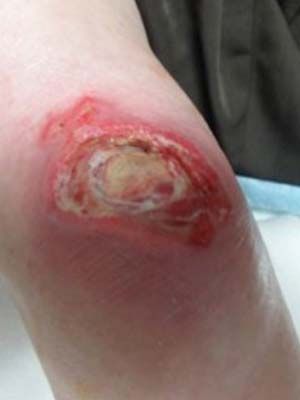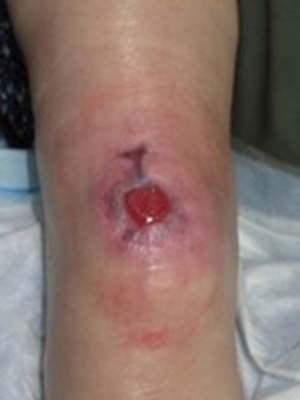- Usage
- Usage Cases
- Pressure Injury. Right BKA. Prosthesis-related injury.
Case №29
Pressure Injury. Right BKA. Prosthesis-related injury
Age of Wound: Unknown
-
Gender:Man
-
Age:82 Years
-
Diagnosis:Pressure Injury
Treatment of pressure ulcers depending on the stage
The process of treating purulent and inflammatory formations that arise due to compression requires an immediate start. This is necessary in order to stop the process and prevent further development of skin lesions.
First, a special inflatable circle is placed under the inflamed area, which will help to reduce the pressure on this area and will promote healing. Secondly, it is very important to provide constant or maximum possible access to the site of air inflammation. Be sure to pay attention to the dryness of those areas that are lesions.
The choice of the type of therapy directly depends on the stage of the process. The so-called superficial purulent wounds, which are considered stages I and II, are much easier to heal than an already prolonged process. If the inflammation is in the first stage, then a slight swelling, redness may form on the surface of the skin in this area, as a result of pressure, the skin turns white.
To speed up healing, the affected area is treated with disinfectants, such as camphor alcohol. Then use sea buckthorn oil or Japanese sophora extract, which will help to enhance the regeneration processes. The second stage of inflammation may be accompanied by some amount of necrotic tissue, therefore, it looks very much like a blister.
For treatment, it is recommended to use antiseptics, and then use ointments with high healing properties (Levomekol, Actovegin, etc.). A good result is given by applications with drugs such as Multiferm.
How to treat pressure ulcers stage III and IV will tell the surgeon who will teach you how to perform the treatment of the wound and apply a bandage. Implementation of his recommendations in full is a guarantee of the patient's success and recovery. To avoid surgical intervention, attention must be paid to the prevention of the formation of purulent inflammation.
Stage III – IV deep wounds are characterized by an intense inflammatory process, which is not only characterized by the presence of pus, but can also affect deeper tissues, as well as tendons or even bone. To carry out a high-quality sanitation of the resulting lesions, it is recommended to go to surgery, where a competent doctor will cleanse the wound from accumulated pus, prevent infection, and use wound healing agents with a very high intensity.
For deep wounds, use the Mirragen matrix, which is added no more than once within 4-5 days. If a large amount of pus is released from the wound, then antiseptic fluids are used to wash the wound. If a secondary infection has already joined the purulent inflammation, then the treatment process is supplemented with the use of an antibiotic sensitive to the microflora of the purulent contents of the bedsores.
Prevention
Expensive, painful and long-term therapy may not be required if due attention is paid to the prevention of the formation of purulent wounds. It includes a mandatory change in the position of the patient's body at least once every two hours.
Places of greatest pressure should be lightly massaged, however, it should be remembered that intensive massaging movements of reddened skin should not be used. The comfort and safety of a bed patient will be provided by an anti-decubitus mattress and an adjustable bed, bed linen made of natural materials with a smooth texture. It will not hurt to use funds that deal with diaper rash. Remember, before using any means and medicines, you must consult with a specialist.
Cooperate With Us
or via contact phones or email
-
Conveniently
By contacting only one supplier, our customers receive a wide range of products in the shortest possible time.
-
Simple
Our customers are only required to form an order for the supply of products, we will take care of all further tasks
-
Profitable
We save our customers money on import
and delivery taxes



